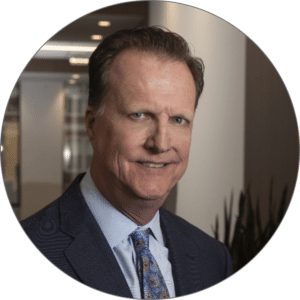
The Overlooked Imperative For New Healthcare CEOs.
By Neill Marshall, Chairman, HealthSearch Partners and Kurt Mosley, Associations Practice Leader, HealthSearch Partners

Burl Stamp, FACHE, (pictured above) is the president and founder of Stamp & Chase, a healthcare performance improvement firm based in St. Louis. Working alongside health care professionals from the boardroom to the bedside, Burl’s firm helps health systems improve employee engagement, patient experience and operational performance by building effective communication competencies and practices at all levels of the organization. Prior to launching Stamp & Chase in 2003, Burl served several leading health care organizations in executive roles, including President/CEO of Phoenix Children’s Hospital and VP at BJC Healthcare. He is the author of The Healing Art of Communication and a frequent speaker on communication, leadership, organizational culture, and business development strategy in health care organizations.
This latest installment in our First 90 Days series features thoughts from Burl Stamp, FACHE, president and founder of Stamp & Chase, a healthcare performance improvement firm based in St. Louis. When healthcare leaders step into a new role, the pressure to focus inward can feel overwhelming: new team, new board, new financial and operational challenges. But according to former hospital CEO and veteran leadership strategist Stamp, if you’re not also focusing outward—on civic, governmental, and business relationships—you’re missing half the job.
The Community As A Stakeholder
“Especially in nonprofit healthcare, your shareholders are the community,” Stamp said in a recent interview. “You have to understand how they see your organization, and how they expect it to serve.”
As the founding CEO of Phoenix Children’s Hospital, Stamp lived this philosophy from day one. Before assessing internal performance metrics or reorganizing departments, he prioritized meetings with civic leaders, business executives, elected officials, and even competitors. He wasn’t simply introducing himself—he was building what he calls a “relational infrastructure” that would support the organization far beyond his first 90 days.
That network proved instrumental. One of his earliest wins came through an early meeting with leadership at the Mayo Clinic, which helped Phoenix Children’s establish a joint pediatric bone marrow transplant program. A consultant’s strategic plan didn’t spark the collaboration, it began with and was advanced by a conversation.
From Operations To Outward-Facing Leadership
Stamp’s advice is echoed in a recent Becker’s Hospital Review article, The Skills CEOs Are Building in 2025, which asked new and seasoned CEOs what they’re working on in the current healthcare landscape to strengthen their organizations. Mandy Eaton, PhD, CEO of Memorial Health in Springfield, Illinois, offered one of the most compelling insights:
“Transitioning from a background heavily focused on internal operations, I’m embracing the challenge of being the public face of our organization… I’m fortunate to have the guidance of my predecessor to help me make the right connections and establish these key relationships.”
Eaton’s words underscore Stamp’s core message: external leadership is not a “nice-to-have,” but a core competency for modern healthcare executives. As systems become more complex and communities more vocal, the ability to build trust with donors, partner organizations, and government entities becomes a defining trait of successful CEOs.
Healthcare Is Local — But Influence Isn’t
Stamp believes that building external relationships is not just about goodwill, it’s about influence for a new CEO. “One of the biggest mistakes new leaders make is waiting to build relationships with policymakers or peer institutions until they need something,” he said.
Engaging government leaders—city officials, legislators, public health administrators—early helps ensure your organization is part of conversations around regulation, funding, and health equity. As Stamp put it, “You want to be seen as a collaborative force, not a squeaky wheel that only shows up when there’s a problem.”
In his tenure, proactive outreach positioned Phoenix Children’s as a trusted voice in pediatric care, which translated into public and private support for its expansion. Whether you’re running a regional system or a major academic medical center, being embedded in the civic fabric of your community is crucial.
Early Wins Start Outside The Building
Most new leaders focus on early wins inside the organization: tweaking org charts, shifting metrics, or launching listening tours. Stamp doesn’t discount those. But he’s adamant that external wins can be just as important, and often overlooked.
In his first 90 days, he advises new CEOs to:
- Meet with the mayor and key city officials. Understand their view of the hospital’s role in the community and listen to their priorities.
- Connect with peers and “competitors.” Opportunities for partnership are often hidden behind historical silos, especially in pediatric or specialty.
- Schedule time with major donors and community foundation leaders. Early rapport-building can lead to long- term funding relationships.
One of Stamp’s favorite tactics is to seek out a respected business leader, someone not directly involved with healthcare, and ask, “If you were in my role, what would you want to know about this community?” The answer may surprise you and guide your next 89 days.
Internal Culture Still Matters—But It’s Not Enough
Of course, external credibility means little without internal clarity. The best leaders bridge both. As Becker’s noted in the same article, “Today’s CEOs must become expert communicators, not just inside the boardroom, but in the broader marketplace.”
Because understanding an organization’s culture is critically important for a new CEO, Stamp recommends conducting anonymous interviews and focus groups with staff, middle managers, physicians, and senior leaders to gain honest insights about the organization’s strengths and challenges.
“While visibility and ‘listening tours’ are important for a new CEO during the first 90 days, the reality is that frontline staff and leaders are going to be reluctant to be completely open regarding their concerns and things they’d like to see changed under new leadership,” Stamp explained. “We’ve found that qualitative research by a neutral third party is welcomed by staff because it creates a safe environment to be candid about both positives and issues in the organization’s culture.”
To help leaders better understand what’s happening in the trenches, his firm has developed an “Experience Snapshot” process that encompasses a week of one-on-one intervews with senior leaders and group discussions of 15-20 people for frontline staff. It culminates in an immediate debrief with executive leadership and a full report within 2-3 weeks.
“The deliverable from this week of interviews and focus groups is an understanding of critical common themes to improve culture and performance, not simply individual grievances,” Stamp said.
He describes the first 90 days as a dual mission: building trust inside and out. Internally, that means clarity around mission, transparent communication, and a structured onboarding plan with the executive team and board. Externally, it means humility, curiosity, and showing up in rooms where hospital CEOs aren’t always expected, but should be welcomed.
Stamp believes this mindset, respecting governance, listening first, and engaging broadly, is what separates effective CEOs from short-tenured ones.
Practical Advice: A Checklist from Burl Stamp
Here are a few key actions Stamp recommends to every new CEO in his or her first 90 days:
- Identify your top five most influential external stakeholders—and go to them. Don’t wait for a crisis to initiate trust.
- Make yourself visible in the community. Speak at a Rotary Club. Attend a Chamber event. Visit a local school.
- Partner early. Find one cross-institutional collaboration (clinical, academic, or civic) to initiate or revive.
- Schedule standing meetings with the board chair and physician leadership, not for updates, but for perspective.
- Meet with the largest payors—including government liasons. Understand how they evaluate your performance, what quality metrics matter most, and what opportunities exist for collaboration.
Final Thought: Leadership Is A Contact Sport
The first 90 days set the tone. And for CEOs, that tone must extend well beyond the executive suite. As Stamp told us, “Too many new leaders think culture is only about what happens inside your organization. In many ways it starts in the community. That’s where your credibility lives or dies.”
So if you’re walking into a new leadership role, don’t just round in the ICU. Round at City Hall. Knock on doors. Be visible.
Because leadership doesn’t just happen inside your walls, it begins, and ultimately succeeds, on the outside.
Stay tuned for more insights as we continue exploring the innovative tactics used by healthcare leaders to make their first 90 days count.
If you have adopted these tactics, or any others featured in this series, we’d love to hear from you. Please contact us to share your story.

